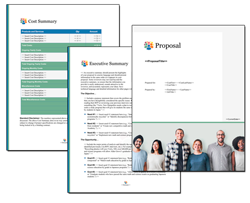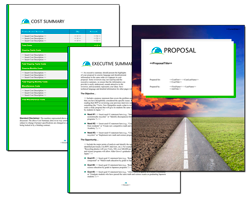
How to Write a Proposal for a Non-Profit: Step-by-Step Success Strategies
How do I write a grant proposal for a non-profit that captures attention and secures funding? We will outline the steps to create a narrative, a cohesive plan, and a budget that makes sense to funders, preparing you to create a winning proposal.
Key Takeaways
- A compelling narrative is crucial in a nonprofit grant proposal. It intertwines the organization's mission and vision with community needs and personal stories to create a convincing and humanizing connection with funders.
- A successful grant proposal must include: A clear problem statement, SMART objectives, a coherent project plan, a transparent budget, an evaluation plan to showcase the project's potential impact and the nonprofit's accountability.
- Building relationships with funders, tailoring proposals to the objectives of the funding organization, leveraging tools for collaborative proposal management, and ensuring meticulous compliance with grant guidelines are all essential strategies for securing nonprofit funding.
- Understanding the grant proposal writing process, including preparing a well-written letter of inquiry, is crucial. This stage helps generate interest from grantmakers and align the proposal with the funding organization's specific requirements.
Creating Your Nonprofit's Narrative

At the heart of every successful grant proposal is a narrative that breathes life into your organization's mission. It's a story that weaves the essence of your nonprofit with the threads of community needs and aspirations. Start by setting the stage with your organization's mission, the beacon guiding your actions, vision, and the horizon you strive towards.
Next, anchor your narrative in the lived experiences of those you serve. Intertwine the tales of individuals and communities with your team's expertise and past triumphs. This humanizes your proposal and forges a connection that can captivate your potential funders. Your unique story and offer will set you apart from competing nonprofit grant proposals.
Components of a Nonprofit Grant Proposal
You will combine several elements that collectively tell the complete story of your project. It begins with the problem statement, setting the stage for unfolding the narrative. From here, each component, from goals to budget, must be interwoven, ensuring the proposal speaks with one coherent and consistent voice.
Successful grant proposals emphasize the importance of building relationships with grantors, understanding their funding interests, and aligning the organization's mission with the funding priorities.
Executive Summary: Your Proposal at a Glance

The executive summary is your opening act, a brief but powerful overview of what's to come. This elevator pitch must capture the essence of your proposed project in a snapshot, compelling the reader to continue considering your offer.
Consider this section the roadmap that guides your readers through your proposal, highlighting your proposed solution to the problem statement. It sets the expectation and primes the funder for the details to follow.
Project Goals and Objectives: The Roadmap to Impact
Your project goals and objectives are the compass that steers the project toward its intended impact. They are created following the SMART criteria, ensuring each step on the roadmap is:
- Specific
- Measurable
- Achievable
- Relevant
- Time-bound
These goals are the milestones that mark your progress, the objectives, and the pathways to reaching them. Together, they form a coherent and credible promise of the impact your nonprofit organization is ready to make, supported by a detailed project plan outlining the steps and timelines for achieving these goals.
Budget Breakdown: Mapping Project Costs

A transparent and well-articulated budget is the backbone of your proposal. It reassures funders of your nonprofit's ability to manage funds and demonstrates a clear understanding of the financial issues of your project.
Detail every dollar, from the salaries of dedicated staff to equipment maintenance. Ensure your budget reflects a realistic and comprehensive view of the resources required to achieve your vision.
Using Proposal Kit for Nonprofit Proposals
Proposal Kit streamlines the grant writing process. It offers a nonprofit grant proposal creation program that guides your organization's efforts. Think of it as the master craftsman's tool, shaping the raw materials of your proposal into a polished finished product.
The proposals you create with Proposal Kit show funders the professionalism of your organization and the care you took in aligning your proposal with their expectations and criteria. It's not just about making the process easier; it's about elevating the quality of your grant applications.
Securing Funding: Tailoring Your Proposal to Funding Organizations
Securing funding from a funding organization is like finding the right key to unlock the door to resources. It requires an articulate proposal that fits the funder's objectives and mission. It must also adhere to the RFP guidelines and instructions as much as it needs to be well-written.
To build a tiered strategy that prioritizes potential funders, follow these steps:
- Assess your relationship strength with each potential funder.
- Evaluate the alignment between your project and the funder's interests.
- Prioritize funders based on the strength of your relationship and alignment with their interests.
By following these steps, you can increase your chances of securing funding for your project through a successful grant application, ultimately obtaining grant funding.
Use the Proposal Kit to tailor your responses to funders' Requests for Proposals (RFPs). Ensure your proposal reflects a deep understanding of the funder's initiatives and how your project complements them. This targeted approach can increase your chances of securing the funding you seek.
Your Cover Letter

The cover letter is the handshake before the conversation; it introduces your nonprofit and the essence of your funding request. It's the space where you align your mission with the funder's goals, drawing them into the story you're about to tell.
A personalized touch can transform a standard cover letter into an invitation to read on. Reference recent interactions with the funder to show your engagement is thoughtful and ongoing. Precise language conveys confidence and clarity, setting the tone for the proposal.
Developing a Winning Project Plan
At the core of a successful grant proposal is a robust project plan that includes:
- Identifying a gap in community needs
- Proposing clear, targeted goals to bridge the gap
- Demonstrating preparedness through detailed support structures such as staff expertise and community involvement
Incorporating a logic model into your project plan can visually represent the resources, activities, and intended impacts, making it easier for funders to grasp your project's effectiveness. It's like a blueprint that ensures every brick laid contributes to the overarching structure of your nonprofit's goals.
Demonstrating Accountability: The Evaluation Plan
An evaluation plan is your commitment to accountability. It details how you measure your project's success against its stated goals and objectives. It differentiates between immediate results and long-term changes, ensuring you capture the full spectrum of your project's impact.
Whether you choose an internal or external evaluator, your evaluation plan is a tool for continuous improvement. It acts as a feedback loop, helping you, your team, and your funders understand the project's effectiveness and adapt as necessary.
Building Relationships Through Your Proposal

A proposal is more than a document - it's a relationship builder. Establishing a connection with funders before you send your proposal can lay a foundation of trust and mutual understanding. Regular updates and personalized communications keep funders informed and invite them to become integral parts of the project's journey.
Show your appreciation for funders in both public and private ways. Acknowledge their support in your materials and through personal gestures, reinforcing the partnership and increasing the likelihood of ongoing support.
Leveraging Tools for Proposal Management
Effective proposal management is facilitated by tools that enable collaboration and organization. Cloud-based storage and online platforms allow your team to work together seamlessly, respond to updates in real-time, and maintain a unified vision.
Proposal Kit is a key non-profit tool that provides a structured approach to creating custom proposal documents. It's a hub that centralizes grant writing efforts, making them easier to manage and more likely to succeed.
Here are some related samples included in every downloadable Proposal Pack
The AI Writer generates a first draft of these templates - customized to your company, client, and project - in just minutes, giving you a head start on editing. Get any Proposal Pack or Proposal Kit Professional, and all of these samples, and the AI Writer are included.
- Educational Grant Sample Proposal
- Educational Grant Sample Proposal #2
- Non-profit Support Sample Proposal
- Research Assistant Sample Proposal
- Healthcare Grant Sample Proposal
- Church Mission Shelter Sample Proposal
- Auction Fundraiser Sample Proposal
- Research Funding Request Proposal
- Research Sample Proposal
- School Funding Request Sample Proposal
- Agricultural Grant Funding Sample Proposal
- Ranching Educational Grant Funding Sample Proposal
- Animal Rescue Shelter Sponsorship Sample Proposal
- Orphanage Non-Profit Funding Sample Proposal
- Political Action Committee (PAC) Sample Proposal
Here are some related downloadable templates
The AI Writer generates a first draft of these templates - customized to your company, client, and project - in just minutes, giving you a head start on editing. Get any Proposal Pack or Proposal Kit Professional, and all of these templates and the AI Writer are included.
- Charity Fundraiser Proposal Template
- Community Center Funding Proposal
- Community Garden Project Proposal
- Community Self-Reliance Initiative Proposal
- Fighting Discrimination Funding Proposal
- Food Aid Grant Project Proposal
- Fundraising Support Proposal
- Grief Counseling Non-Profit Seeking Funding Proposal
- Gun Control Legislation Proposal
- Halfway House Proposal
- Homeless Womens Shelter Non-Profit Funding Proposal
- Humanitarian Aid Services Support Proposal
- Indigenous Community Funding Project Proposal
- Meals To Go Service Proposal Template
- Mens Center Funding Proposal
- Mobile Literacy Program Funding Proposal
- Museum Conservation Project Proposal
- Non-Profit Parenting Distance Learning and Workshop Proposal
- Non-profit Support Proposal
- Orphanage Non-Profit Funding Support Proposal
- Outreach Center Funding Proposal
- Political Action Proposal
- Popup Kitchen Community Support Funding Proposal
- Preservation of a Native Culture and Language Proposal
- Standard of Living Improvement Proposal
- Teen Center Funding Proposal
- Transitional Housing Funding Proposal
- Transitional Housing Project Proposal
- Womens Center Funding Proposal
Aligning with Grant Guidelines: Ensuring Compliance
Compliance with grant guidelines is non-negotiable. Every funder's submission requirements are a unique puzzle, and your proposal must fit perfectly within its framework to be considered. Keep abreast of funders' shifting priorities and ensure your proposal speaks directly to their mission and goals.
Most non-profit proposals are responses to grants and RFPs, which means there are usually RFP instructions that must be followed. Your proposal could be rejected on a technicality if you fail to follow the instructions.
A meticulous copyediting process is crucial here - it's the final check to ensure that every i is dotted and the funder's unique criteria cross every t. This attention to detail can be the difference between acceptance and rejection.
Showcasing Organizational Strengths

Your proposal should serve as a gallery showcasing your organization's best work and strengths. Highlight your track record, outcomes, and impact to demonstrate your capacity for success and credibility.
Presenting financial stability within your proposal reassures funders of your nonprofit's ability to manage their investment responsibly. It's a testament to your good governance practices and long-term viability.
The Final Review: Polishing Your Proposal
The final review of your proposal is like preparing for opening night. Every detail must be scrutinized, and each element of your organization's mission and goals must shine through clearly to convey potential impact.
Seek an unbiased perspective for this final polish, inviting team members or external consultants to review. They can provide fresh insights and ensure that your proposal is not only free of errors but also compelling and complete.
 Proposal Kit Professional provides the most content, including legal contracts and a free design theme pack. Plus, advanced software features include custom branding and customizable quoting databases.
Proposal Kit Professional provides the most content, including legal contracts and a free design theme pack. Plus, advanced software features include custom branding and customizable quoting databases. Proposal Pack for Any Business covers this type of proposal and includes samples. There are also some commonly used specialty design themes available:
Proposal Pack for Any Business covers this type of proposal and includes samples. There are also some commonly used specialty design themes available:Photo Design Proposal Packs
 Proposal Pack Business #20
Proposal Pack Business #20 Proposal Pack Children #3
Proposal Pack Children #3 Proposal Pack Classic #21
Proposal Pack Classic #21 Proposal Pack Community #1
Proposal Pack Community #1 Proposal Pack Community #2
Proposal Pack Community #2 Proposal Pack Concepts #16
Proposal Pack Concepts #16 Proposal Pack Concepts #17
Proposal Pack Concepts #17 Proposal Pack Environmental #4
Proposal Pack Environmental #4 Proposal Pack Environmental #5
Proposal Pack Environmental #5 Proposal Pack People #4
Proposal Pack People #4 Proposal Pack People #5
Proposal Pack People #5 Proposal Pack Spiritual #4
Proposal Pack Spiritual #4
Summary

A successful grant proposal is a symphony of narrative, planning, and relationship-building. The harmonious blend of a story, a detailed project plan, and a managed proposal process resonates with funders and paves the way for impact.
With the right approach, tools, and adherence to funders' guidelines, your organization can secure the funding to make a meaningful difference in the world.
Frequently Asked Questions
How do I ensure my proposal aligns with a funder's mission?
To ensure your proposal aligns with a funder's mission, research their current interests and tailor your project's objectives to match their mission. Using tools like Proposal Kit can help customize your response.
What are the key components of a nonprofit grant proposal?
The key parts of a non-profit grant proposal include a clear problem statement, SMART project goals and objectives, a detailed budget breakdown, an engaging cover letter, and an executive summary. Consistency and clarity are crucial across all these elements.
How can I demonstrate my nonprofit's credibility in the proposal?
In the proposal, you can demonstrate your nonprofit's credibility by showcasing its strengths, such as a track record of success, outcomes of past projects, and evidence of financial stability, to build trust and prove your capacity to use the funds.
What tools can help me manage the grant proposal writing process?
Consider using cloud-based storage, online collaboration platforms, and a tool like Proposal Kit to centralize grant writing efforts and create compelling custom proposal documents. These tools can streamline and organize the proposal writing process effectively.
How important is the evaluation plan in my proposal?
The evaluation plan is crucial in your proposal. It measures the success of your project and ensures accountability. It should encompass both short-term outputs and long-term outcomes through quantitative and qualitative assessment methods.



 Cart
Cart
 Are you just looking for a template, sample, or software for your non-profit proposals? Click these links to skip down the page and get right to it.
Are you just looking for a template, sample, or software for your non-profit proposals? Click these links to skip down the page and get right to it.

 Facebook
Facebook YouTube
YouTube Bluesky
Bluesky Search Site
Search Site